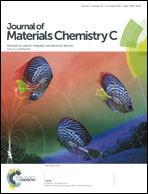Synthesis and characterization of novel electrochromic and photoresponsive materials based on azobenzene-4,4′-dicarboxylic acid dialkyl ester†
Abstract
Novel electrochromic and photoresponsive materials based on azobenzene-4,4′-dicarboxylic acid dialkyl ester derivatives (ADDEDs) were successfully prepared and characterized through nuclear magnetic resonance spectroscopy, Fourier transform infrared spectroscopy, and high-performance liquid chromatography-mass spectrometry. The electrochromic behavior, electrochromic mechanism, electro-optical properties, and photoresponsive properties of ADDEDs were investigated through cyclic voltammetry and ultraviolet-visible absorption spectra. ADDEDs displayed not only outstanding electrochromic behavior but also good and reversible photoisomerization properties even under electrochromic conditions. Electrochromic devices (ECDs) based on ADDEDs were fabricated, and their electrochromic performance was analyzed. The ECDs presented a color change from colorless to magenta between 0.0 V (bleached state) and ±3.0 V (colored state). In addition, the ECDs exhibited fast switching times, reasonable contrast, satisfactory optical memories, and redox stability. The novel redox-active azobenzene derivatives are promising candidates for full-color EC display devices, electronic paper, smart windows, optical memory devices, dual-stimuli-responsive systems, as well as other potential new applications.


 Please wait while we load your content...
Please wait while we load your content...